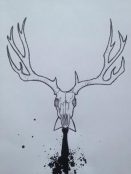[dropcap style=”font-size:100px; color:#992211;”]S[/dropcap]cientists developing cloaking systems hit upon the idea of disguising things as something else, rather than trying to make them disappear entirely.
In essence, creating a Somebody Else’s Problem field, as described by Douglas Adams, rather than an Invisibility Cloak, as plotted by J.K. Rowling.
Techies, eh. Where do they get their ideas?
Developing the cloak of invisibility would be wonderful, but sometimes simply making an object appear to be something else will do the trick, according to Penn State electrical engineers.
“Previous attempts at cloaking using a single metasurface layer were restricted to very small-sized objects,” said Zhi Hao Jiang, postdoctoral fellow in electrical engineering, Penn State. “Also, the act of cloaking would prevent an enclosed antenna or sensor from communicating with the outside world.”
Jiang and Douglas H. Werner, John L. and Genevieve H. McCain Chair Professor of Electrical Engineering, developed a metamaterial coating with a negligible thickness that allows coated objects to function normally while appearing as something other than what they really are, or even completely disappearing. They report their research in Advanced Functional Materials.
The researchers employ what they call “illusion coatings,” coatings made up of a thin flexible substrate with copper patterns designed to create the desired result. They can take a practical size metal antenna or sensor, coat it with the patterned film and when the device is probed by a radio frequency source, the scattering signature of the enclosed object will appear to be that of a prescribed dielectric material like silicon or Teflon. Conversely, with the proper pattern, they can coat a dielectric and it will scatter electromagnetic waves the same as if it were a metal object.
“The demonstrated illusion/cloaking coating is a lightweight two-dimensional metasurface, not a bulky three-dimensional metasurface,” said Werner.
The researchers take the object they want cloaked and surround it with a spacer, either air or foam. They then apply the ultrathin layer of dielectric with copper patterning designed for the wavelengths they wish to cloak. In this way, antennae and sensors could be made invisible or deceptive to remote inspection.
Source: Penn State
Image: www.freedigitalphotos.net/tongdang

Some of the news that we find inspiring, diverting, wrong or so very right.



















